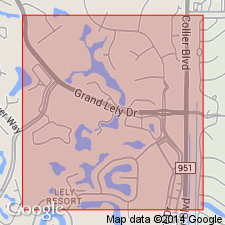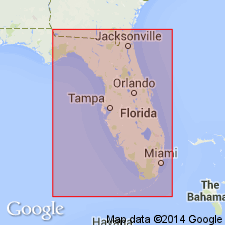
- Usage in publication:
-
- Gordon Pass Formation
- Modifications:
-
- Named
- Dominant lithology:
-
- Anhydrite
- Limestone
- Dolomite
- AAPG geologic province:
-
- Florida platform
Summary:
Gordon Pass Formation, here named, of the Big Cypress Group, consists of anhydrite interbedded with micritic limestone and dolomite. Characterized by a dense limestone at base and a thin anhydrite bed at top. Unit is 159 m thick in the type well. Overlies Marco Junction Formation and underlies Dollar Bay Formation, both also of Big Cypress Group. Age is Early Cretaceous.
Source: GNU records (USGS DDS-6; Reston GNULEX).

- Usage in publication:
-
- Gordon Pass Formation*
- Modifications:
-
- Overview
- AAPG geologic province:
-
- Florida platform
Summary:
Early Cretaceous Gordon Pass Formation of Big Cypress Group used following Faulkner and Applegate (1986, Gulf Coast Association of Geological Societies Transactions, v. 36, p. 83-96) and Lloyd (1991, Florida Geological Survey Information Circular 107, p. 1-62).
Source: GNU records (USGS DDS-6; Reston GNULEX).
For more information, please contact Nancy Stamm, Geologic Names Committee Secretary.
Asterisk (*) indicates published by U.S. Geological Survey authors.
"No current usage" (†) implies that a name has been abandoned or has fallen into disuse. Former usage and, if known, replacement name given in parentheses ( ).
Slash (/) indicates name conflicts with nomenclatural guidelines (CSN, 1933; ACSN, 1961, 1970; NACSN, 1983, 2005, 2021). May be explained within brackets ([ ]).

